Strategic Planning for the Hospitality Industry
VerifiedAdded on 2023/01/06
|10
|3271
|1
AI Summary
This document discusses strategic planning in the hospitality industry, focusing on the case of Hilton Hotel London. It analyzes the factors required to implement a chosen strategy, explores creative business strategies for future competitiveness, and evaluates different performance metrics. The document also covers critical success factors and key performance indicators. Suitable for students studying strategic planning in the hospitality industry.
Contribute Materials
Your contribution can guide someone’s learning journey. Share your
documents today.
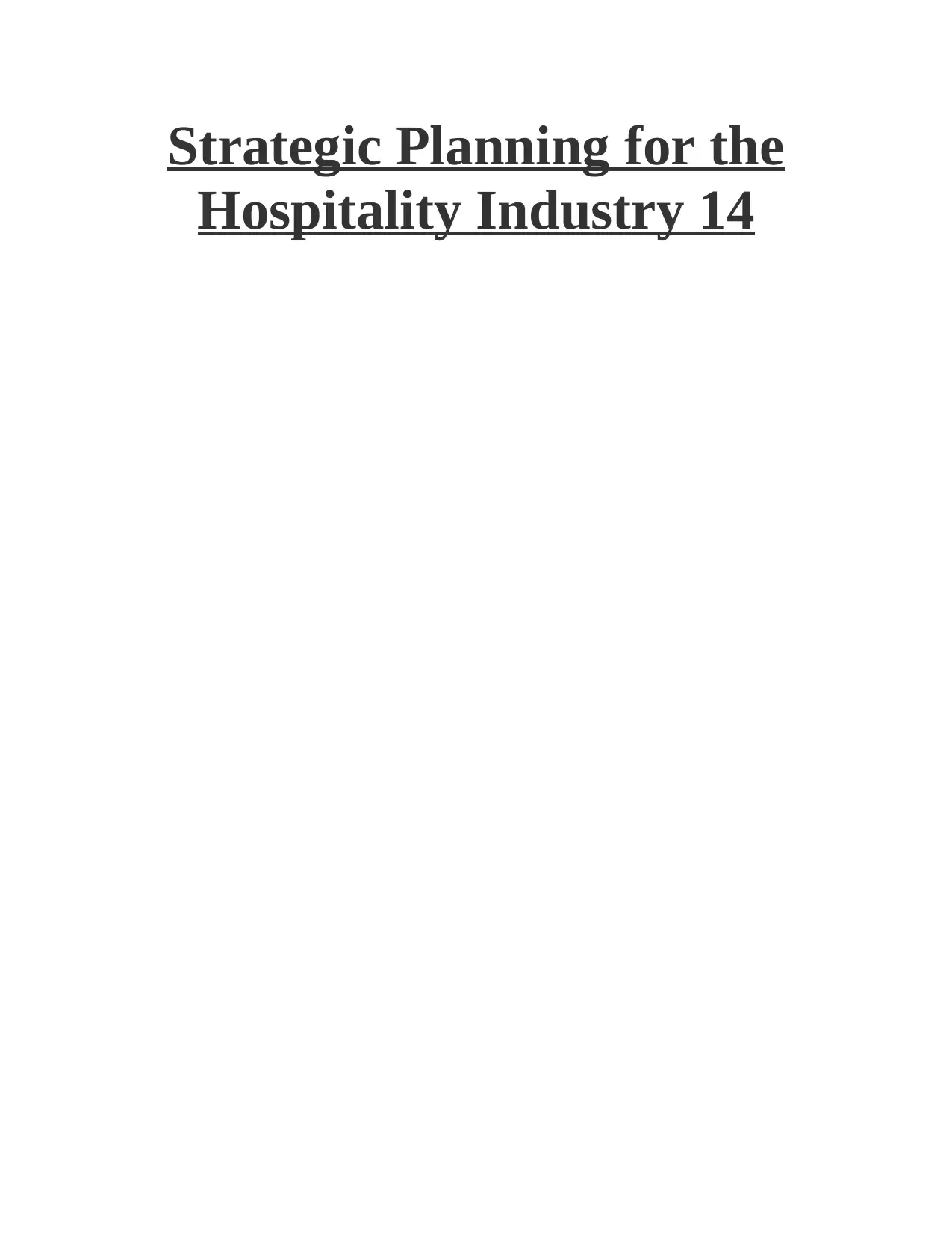
Strategic Planning for the
Hospitality Industry 14
Hospitality Industry 14
Secure Best Marks with AI Grader
Need help grading? Try our AI Grader for instant feedback on your assignments.
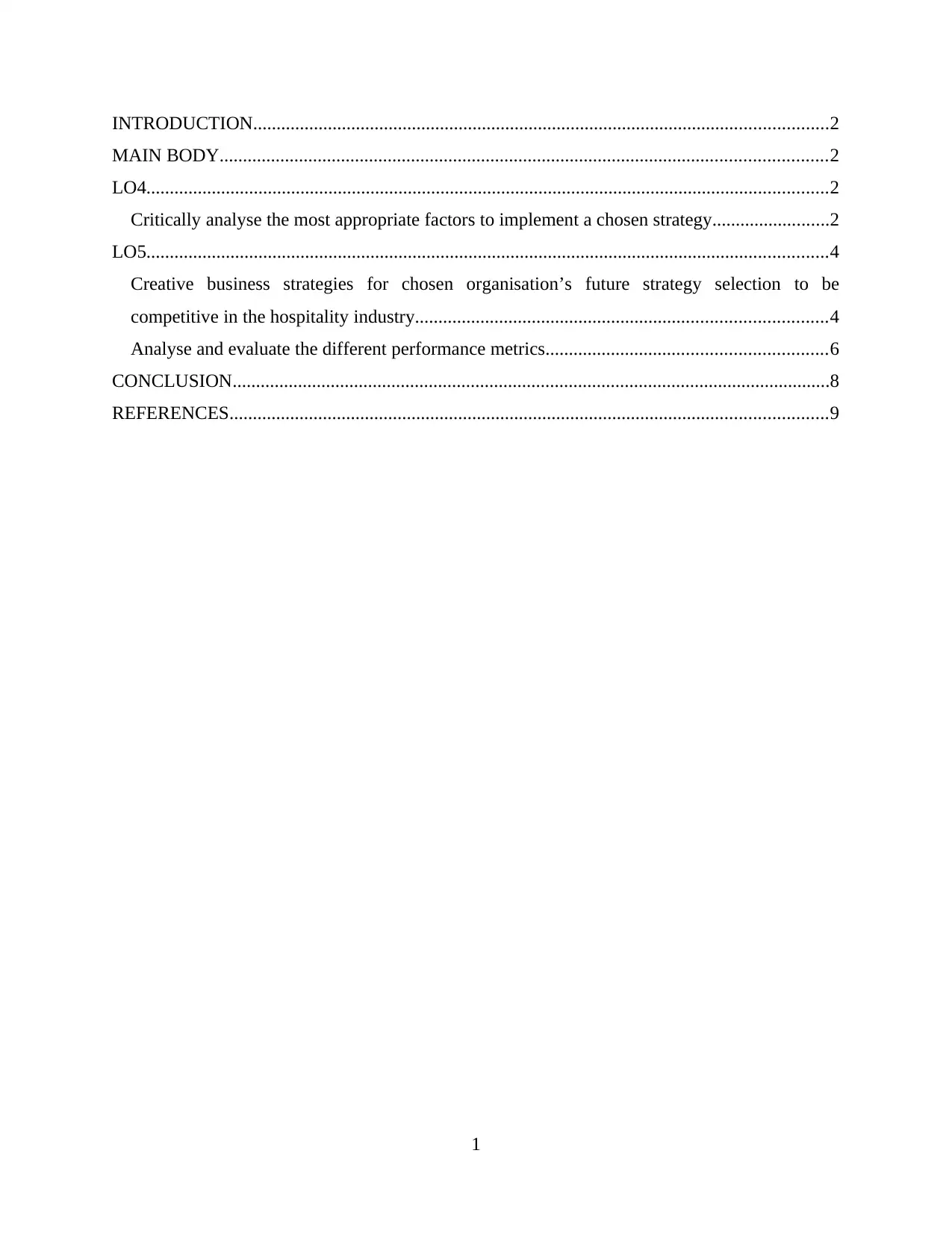
INTRODUCTION...........................................................................................................................2
MAIN BODY..................................................................................................................................2
LO4..................................................................................................................................................2
Critically analyse the most appropriate factors to implement a chosen strategy.........................2
LO5..................................................................................................................................................4
Creative business strategies for chosen organisation’s future strategy selection to be
competitive in the hospitality industry........................................................................................4
Analyse and evaluate the different performance metrics............................................................6
CONCLUSION................................................................................................................................8
REFERENCES................................................................................................................................9
1
MAIN BODY..................................................................................................................................2
LO4..................................................................................................................................................2
Critically analyse the most appropriate factors to implement a chosen strategy.........................2
LO5..................................................................................................................................................4
Creative business strategies for chosen organisation’s future strategy selection to be
competitive in the hospitality industry........................................................................................4
Analyse and evaluate the different performance metrics............................................................6
CONCLUSION................................................................................................................................8
REFERENCES................................................................................................................................9
1
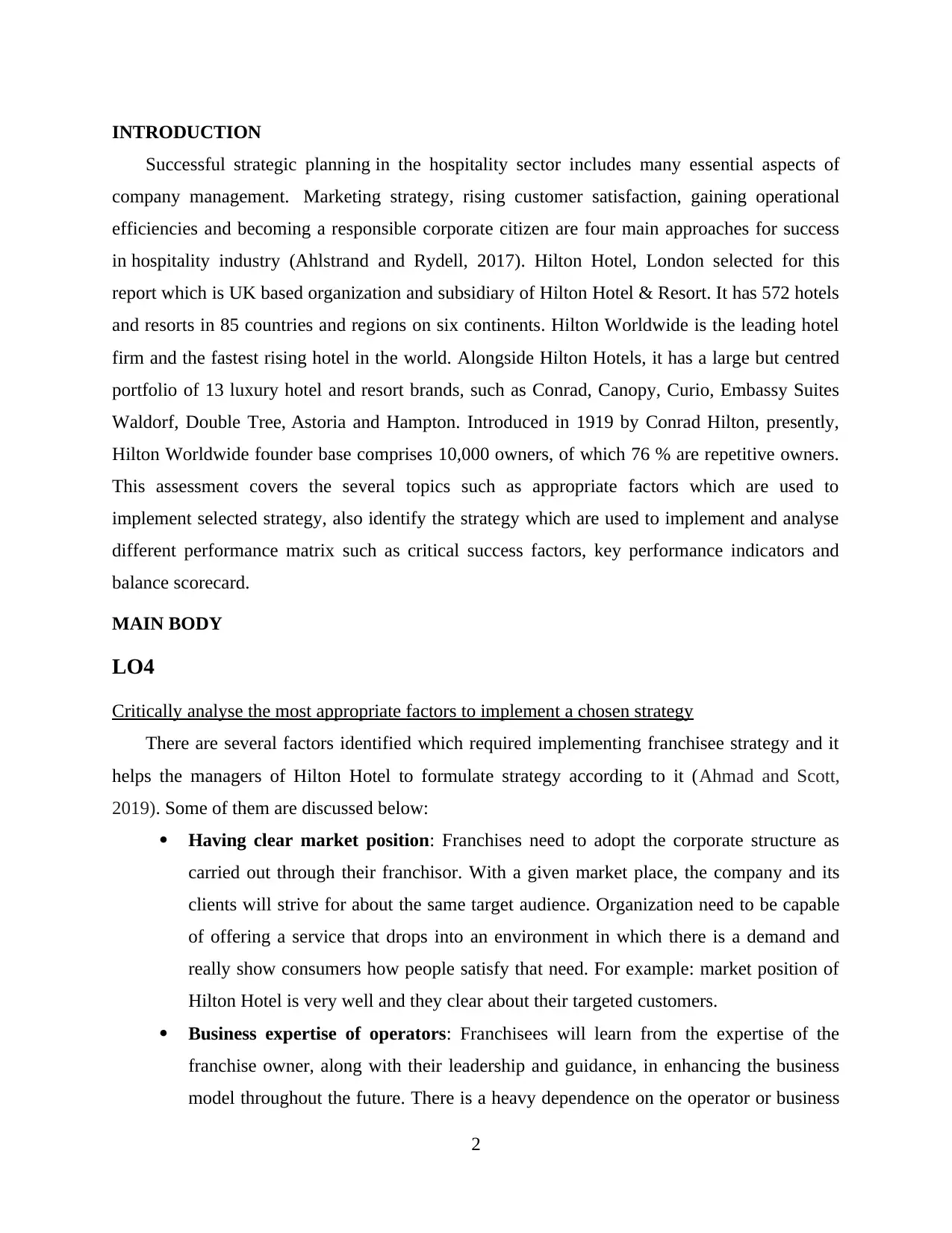
INTRODUCTION
Successful strategic planning in the hospitality sector includes many essential aspects of
company management. Marketing strategy, rising customer satisfaction, gaining operational
efficiencies and becoming a responsible corporate citizen are four main approaches for success
in hospitality industry (Ahlstrand and Rydell, 2017). Hilton Hotel, London selected for this
report which is UK based organization and subsidiary of Hilton Hotel & Resort. It has 572 hotels
and resorts in 85 countries and regions on six continents. Hilton Worldwide is the leading hotel
firm and the fastest rising hotel in the world. Alongside Hilton Hotels, it has a large but centred
portfolio of 13 luxury hotel and resort brands, such as Conrad, Canopy, Curio, Embassy Suites
Waldorf, Double Tree, Astoria and Hampton. Introduced in 1919 by Conrad Hilton, presently,
Hilton Worldwide founder base comprises 10,000 owners, of which 76 % are repetitive owners.
This assessment covers the several topics such as appropriate factors which are used to
implement selected strategy, also identify the strategy which are used to implement and analyse
different performance matrix such as critical success factors, key performance indicators and
balance scorecard.
MAIN BODY
LO4
Critically analyse the most appropriate factors to implement a chosen strategy
There are several factors identified which required implementing franchisee strategy and it
helps the managers of Hilton Hotel to formulate strategy according to it (Ahmad and Scott,
2019). Some of them are discussed below:
Having clear market position: Franchises need to adopt the corporate structure as
carried out through their franchisor. With a given market place, the company and its
clients will strive for about the same target audience. Organization need to be capable
of offering a service that drops into an environment in which there is a demand and
really show consumers how people satisfy that need. For example: market position of
Hilton Hotel is very well and they clear about their targeted customers.
Business expertise of operators: Franchisees will learn from the expertise of the
franchise owner, along with their leadership and guidance, in enhancing the business
model throughout the future. There is a heavy dependence on the operator or business
2
Successful strategic planning in the hospitality sector includes many essential aspects of
company management. Marketing strategy, rising customer satisfaction, gaining operational
efficiencies and becoming a responsible corporate citizen are four main approaches for success
in hospitality industry (Ahlstrand and Rydell, 2017). Hilton Hotel, London selected for this
report which is UK based organization and subsidiary of Hilton Hotel & Resort. It has 572 hotels
and resorts in 85 countries and regions on six continents. Hilton Worldwide is the leading hotel
firm and the fastest rising hotel in the world. Alongside Hilton Hotels, it has a large but centred
portfolio of 13 luxury hotel and resort brands, such as Conrad, Canopy, Curio, Embassy Suites
Waldorf, Double Tree, Astoria and Hampton. Introduced in 1919 by Conrad Hilton, presently,
Hilton Worldwide founder base comprises 10,000 owners, of which 76 % are repetitive owners.
This assessment covers the several topics such as appropriate factors which are used to
implement selected strategy, also identify the strategy which are used to implement and analyse
different performance matrix such as critical success factors, key performance indicators and
balance scorecard.
MAIN BODY
LO4
Critically analyse the most appropriate factors to implement a chosen strategy
There are several factors identified which required implementing franchisee strategy and it
helps the managers of Hilton Hotel to formulate strategy according to it (Ahmad and Scott,
2019). Some of them are discussed below:
Having clear market position: Franchises need to adopt the corporate structure as
carried out through their franchisor. With a given market place, the company and its
clients will strive for about the same target audience. Organization need to be capable
of offering a service that drops into an environment in which there is a demand and
really show consumers how people satisfy that need. For example: market position of
Hilton Hotel is very well and they clear about their targeted customers.
Business expertise of operators: Franchisees will learn from the expertise of the
franchise owner, along with their leadership and guidance, in enhancing the business
model throughout the future. There is a heavy dependence on the operator or business
2
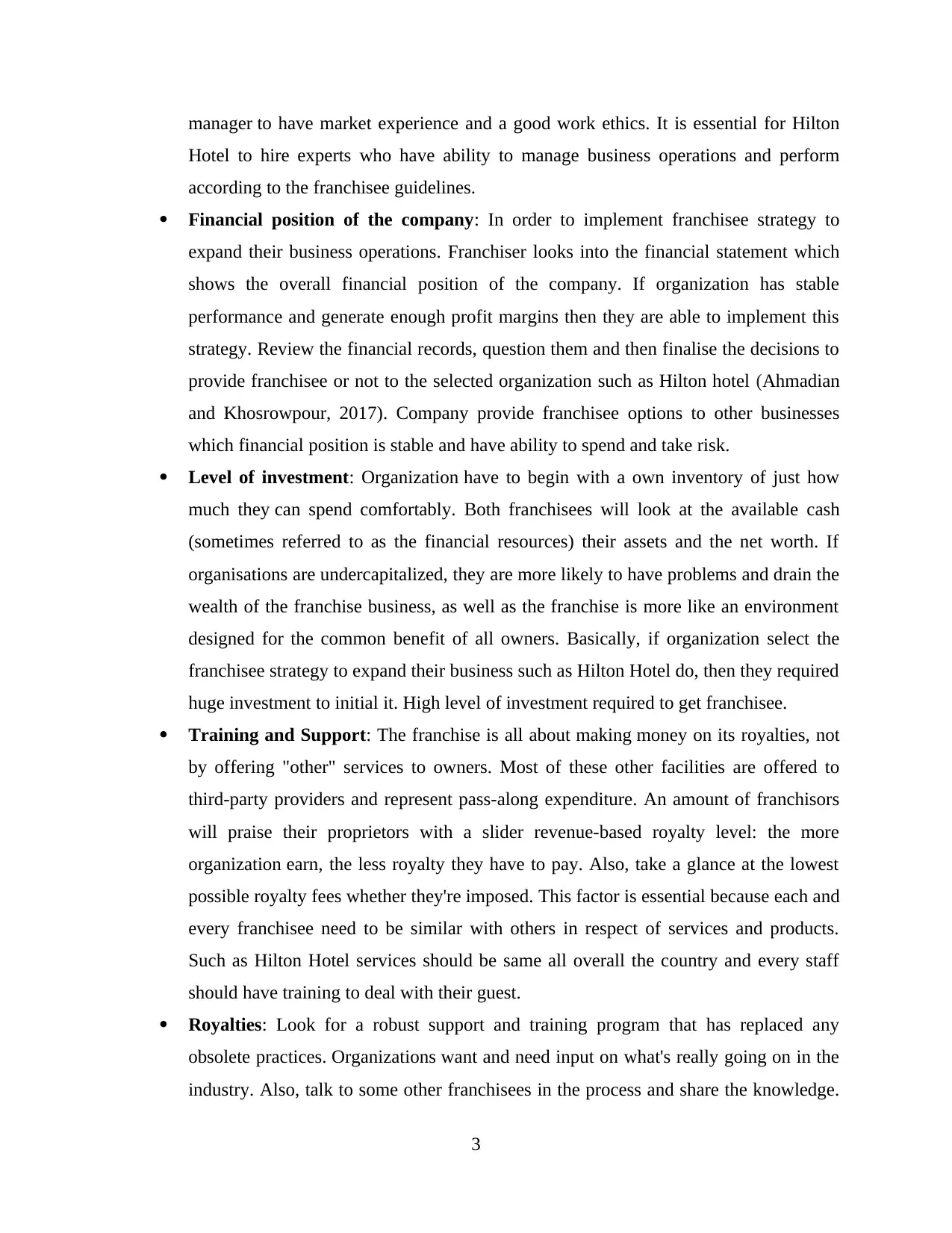
manager to have market experience and a good work ethics. It is essential for Hilton
Hotel to hire experts who have ability to manage business operations and perform
according to the franchisee guidelines.
Financial position of the company: In order to implement franchisee strategy to
expand their business operations. Franchiser looks into the financial statement which
shows the overall financial position of the company. If organization has stable
performance and generate enough profit margins then they are able to implement this
strategy. Review the financial records, question them and then finalise the decisions to
provide franchisee or not to the selected organization such as Hilton hotel (Ahmadian
and Khosrowpour, 2017). Company provide franchisee options to other businesses
which financial position is stable and have ability to spend and take risk.
Level of investment: Organization have to begin with a own inventory of just how
much they can spend comfortably. Both franchisees will look at the available cash
(sometimes referred to as the financial resources) their assets and the net worth. If
organisations are undercapitalized, they are more likely to have problems and drain the
wealth of the franchise business, as well as the franchise is more like an environment
designed for the common benefit of all owners. Basically, if organization select the
franchisee strategy to expand their business such as Hilton Hotel do, then they required
huge investment to initial it. High level of investment required to get franchisee.
Training and Support: The franchise is all about making money on its royalties, not
by offering "other" services to owners. Most of these other facilities are offered to
third-party providers and represent pass-along expenditure. An amount of franchisors
will praise their proprietors with a slider revenue-based royalty level: the more
organization earn, the less royalty they have to pay. Also, take a glance at the lowest
possible royalty fees whether they're imposed. This factor is essential because each and
every franchisee need to be similar with others in respect of services and products.
Such as Hilton Hotel services should be same all overall the country and every staff
should have training to deal with their guest.
Royalties: Look for a robust support and training program that has replaced any
obsolete practices. Organizations want and need input on what's really going on in the
industry. Also, talk to some other franchisees in the process and share the knowledge.
3
Hotel to hire experts who have ability to manage business operations and perform
according to the franchisee guidelines.
Financial position of the company: In order to implement franchisee strategy to
expand their business operations. Franchiser looks into the financial statement which
shows the overall financial position of the company. If organization has stable
performance and generate enough profit margins then they are able to implement this
strategy. Review the financial records, question them and then finalise the decisions to
provide franchisee or not to the selected organization such as Hilton hotel (Ahmadian
and Khosrowpour, 2017). Company provide franchisee options to other businesses
which financial position is stable and have ability to spend and take risk.
Level of investment: Organization have to begin with a own inventory of just how
much they can spend comfortably. Both franchisees will look at the available cash
(sometimes referred to as the financial resources) their assets and the net worth. If
organisations are undercapitalized, they are more likely to have problems and drain the
wealth of the franchise business, as well as the franchise is more like an environment
designed for the common benefit of all owners. Basically, if organization select the
franchisee strategy to expand their business such as Hilton Hotel do, then they required
huge investment to initial it. High level of investment required to get franchisee.
Training and Support: The franchise is all about making money on its royalties, not
by offering "other" services to owners. Most of these other facilities are offered to
third-party providers and represent pass-along expenditure. An amount of franchisors
will praise their proprietors with a slider revenue-based royalty level: the more
organization earn, the less royalty they have to pay. Also, take a glance at the lowest
possible royalty fees whether they're imposed. This factor is essential because each and
every franchisee need to be similar with others in respect of services and products.
Such as Hilton Hotel services should be same all overall the country and every staff
should have training to deal with their guest.
Royalties: Look for a robust support and training program that has replaced any
obsolete practices. Organizations want and need input on what's really going on in the
industry. Also, talk to some other franchisees in the process and share the knowledge.
3
Secure Best Marks with AI Grader
Need help grading? Try our AI Grader for instant feedback on your assignments.
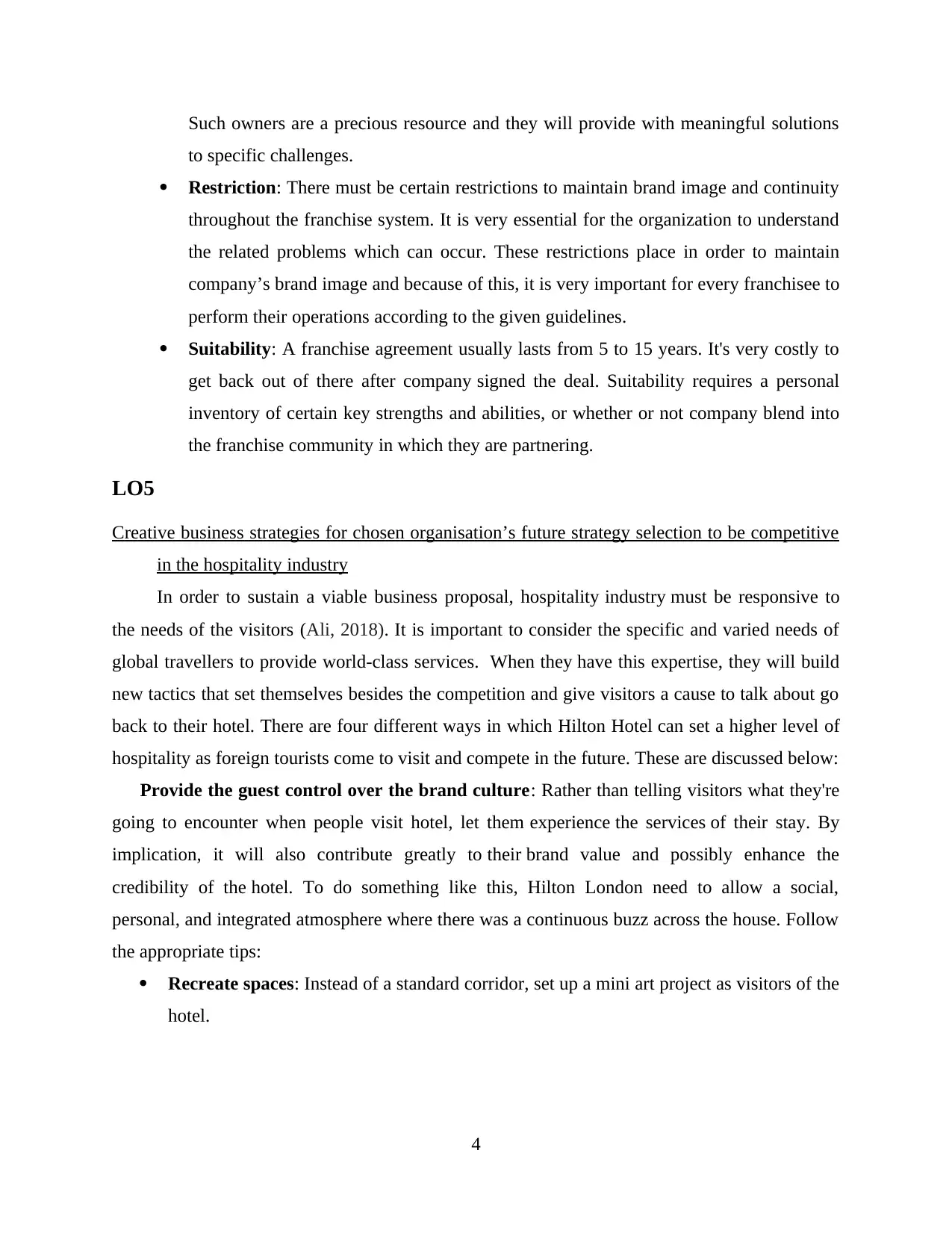
Such owners are a precious resource and they will provide with meaningful solutions
to specific challenges.
Restriction: There must be certain restrictions to maintain brand image and continuity
throughout the franchise system. It is very essential for the organization to understand
the related problems which can occur. These restrictions place in order to maintain
company’s brand image and because of this, it is very important for every franchisee to
perform their operations according to the given guidelines.
Suitability: A franchise agreement usually lasts from 5 to 15 years. It's very costly to
get back out of there after company signed the deal. Suitability requires a personal
inventory of certain key strengths and abilities, or whether or not company blend into
the franchise community in which they are partnering.
LO5
Creative business strategies for chosen organisation’s future strategy selection to be competitive
in the hospitality industry
In order to sustain a viable business proposal, hospitality industry must be responsive to
the needs of the visitors (Ali, 2018). It is important to consider the specific and varied needs of
global travellers to provide world-class services. When they have this expertise, they will build
new tactics that set themselves besides the competition and give visitors a cause to talk about go
back to their hotel. There are four different ways in which Hilton Hotel can set a higher level of
hospitality as foreign tourists come to visit and compete in the future. These are discussed below:
Provide the guest control over the brand culture: Rather than telling visitors what they're
going to encounter when people visit hotel, let them experience the services of their stay. By
implication, it will also contribute greatly to their brand value and possibly enhance the
credibility of the hotel. To do something like this, Hilton London need to allow a social,
personal, and integrated atmosphere where there was a continuous buzz across the house. Follow
the appropriate tips:
Recreate spaces: Instead of a standard corridor, set up a mini art project as visitors of the
hotel.
4
to specific challenges.
Restriction: There must be certain restrictions to maintain brand image and continuity
throughout the franchise system. It is very essential for the organization to understand
the related problems which can occur. These restrictions place in order to maintain
company’s brand image and because of this, it is very important for every franchisee to
perform their operations according to the given guidelines.
Suitability: A franchise agreement usually lasts from 5 to 15 years. It's very costly to
get back out of there after company signed the deal. Suitability requires a personal
inventory of certain key strengths and abilities, or whether or not company blend into
the franchise community in which they are partnering.
LO5
Creative business strategies for chosen organisation’s future strategy selection to be competitive
in the hospitality industry
In order to sustain a viable business proposal, hospitality industry must be responsive to
the needs of the visitors (Ali, 2018). It is important to consider the specific and varied needs of
global travellers to provide world-class services. When they have this expertise, they will build
new tactics that set themselves besides the competition and give visitors a cause to talk about go
back to their hotel. There are four different ways in which Hilton Hotel can set a higher level of
hospitality as foreign tourists come to visit and compete in the future. These are discussed below:
Provide the guest control over the brand culture: Rather than telling visitors what they're
going to encounter when people visit hotel, let them experience the services of their stay. By
implication, it will also contribute greatly to their brand value and possibly enhance the
credibility of the hotel. To do something like this, Hilton London need to allow a social,
personal, and integrated atmosphere where there was a continuous buzz across the house. Follow
the appropriate tips:
Recreate spaces: Instead of a standard corridor, set up a mini art project as visitors of the
hotel.
4
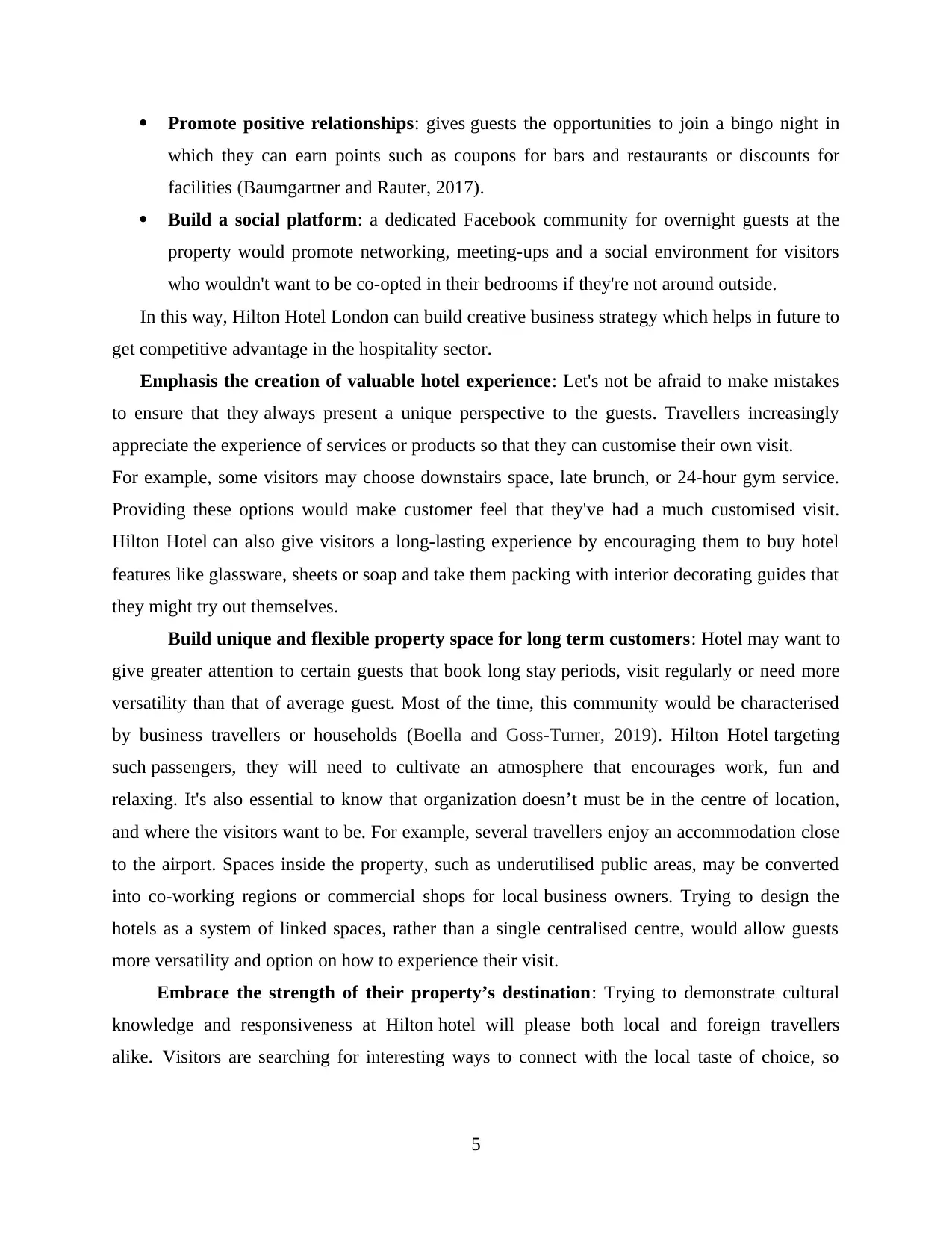
Promote positive relationships: gives guests the opportunities to join a bingo night in
which they can earn points such as coupons for bars and restaurants or discounts for
facilities (Baumgartner and Rauter, 2017).
Build a social platform: a dedicated Facebook community for overnight guests at the
property would promote networking, meeting-ups and a social environment for visitors
who wouldn't want to be co-opted in their bedrooms if they're not around outside.
In this way, Hilton Hotel London can build creative business strategy which helps in future to
get competitive advantage in the hospitality sector.
Emphasis the creation of valuable hotel experience: Let's not be afraid to make mistakes
to ensure that they always present a unique perspective to the guests. Travellers increasingly
appreciate the experience of services or products so that they can customise their own visit.
For example, some visitors may choose downstairs space, late brunch, or 24-hour gym service.
Providing these options would make customer feel that they've had a much customised visit.
Hilton Hotel can also give visitors a long-lasting experience by encouraging them to buy hotel
features like glassware, sheets or soap and take them packing with interior decorating guides that
they might try out themselves.
Build unique and flexible property space for long term customers: Hotel may want to
give greater attention to certain guests that book long stay periods, visit regularly or need more
versatility than that of average guest. Most of the time, this community would be characterised
by business travellers or households (Boella and Goss-Turner, 2019). Hilton Hotel targeting
such passengers, they will need to cultivate an atmosphere that encourages work, fun and
relaxing. It's also essential to know that organization doesn’t must be in the centre of location,
and where the visitors want to be. For example, several travellers enjoy an accommodation close
to the airport. Spaces inside the property, such as underutilised public areas, may be converted
into co-working regions or commercial shops for local business owners. Trying to design the
hotels as a system of linked spaces, rather than a single centralised centre, would allow guests
more versatility and option on how to experience their visit.
Embrace the strength of their property’s destination: Trying to demonstrate cultural
knowledge and responsiveness at Hilton hotel will please both local and foreign travellers
alike. Visitors are searching for interesting ways to connect with the local taste of choice, so
5
which they can earn points such as coupons for bars and restaurants or discounts for
facilities (Baumgartner and Rauter, 2017).
Build a social platform: a dedicated Facebook community for overnight guests at the
property would promote networking, meeting-ups and a social environment for visitors
who wouldn't want to be co-opted in their bedrooms if they're not around outside.
In this way, Hilton Hotel London can build creative business strategy which helps in future to
get competitive advantage in the hospitality sector.
Emphasis the creation of valuable hotel experience: Let's not be afraid to make mistakes
to ensure that they always present a unique perspective to the guests. Travellers increasingly
appreciate the experience of services or products so that they can customise their own visit.
For example, some visitors may choose downstairs space, late brunch, or 24-hour gym service.
Providing these options would make customer feel that they've had a much customised visit.
Hilton Hotel can also give visitors a long-lasting experience by encouraging them to buy hotel
features like glassware, sheets or soap and take them packing with interior decorating guides that
they might try out themselves.
Build unique and flexible property space for long term customers: Hotel may want to
give greater attention to certain guests that book long stay periods, visit regularly or need more
versatility than that of average guest. Most of the time, this community would be characterised
by business travellers or households (Boella and Goss-Turner, 2019). Hilton Hotel targeting
such passengers, they will need to cultivate an atmosphere that encourages work, fun and
relaxing. It's also essential to know that organization doesn’t must be in the centre of location,
and where the visitors want to be. For example, several travellers enjoy an accommodation close
to the airport. Spaces inside the property, such as underutilised public areas, may be converted
into co-working regions or commercial shops for local business owners. Trying to design the
hotels as a system of linked spaces, rather than a single centralised centre, would allow guests
more versatility and option on how to experience their visit.
Embrace the strength of their property’s destination: Trying to demonstrate cultural
knowledge and responsiveness at Hilton hotel will please both local and foreign travellers
alike. Visitors are searching for interesting ways to connect with the local taste of choice, so
5
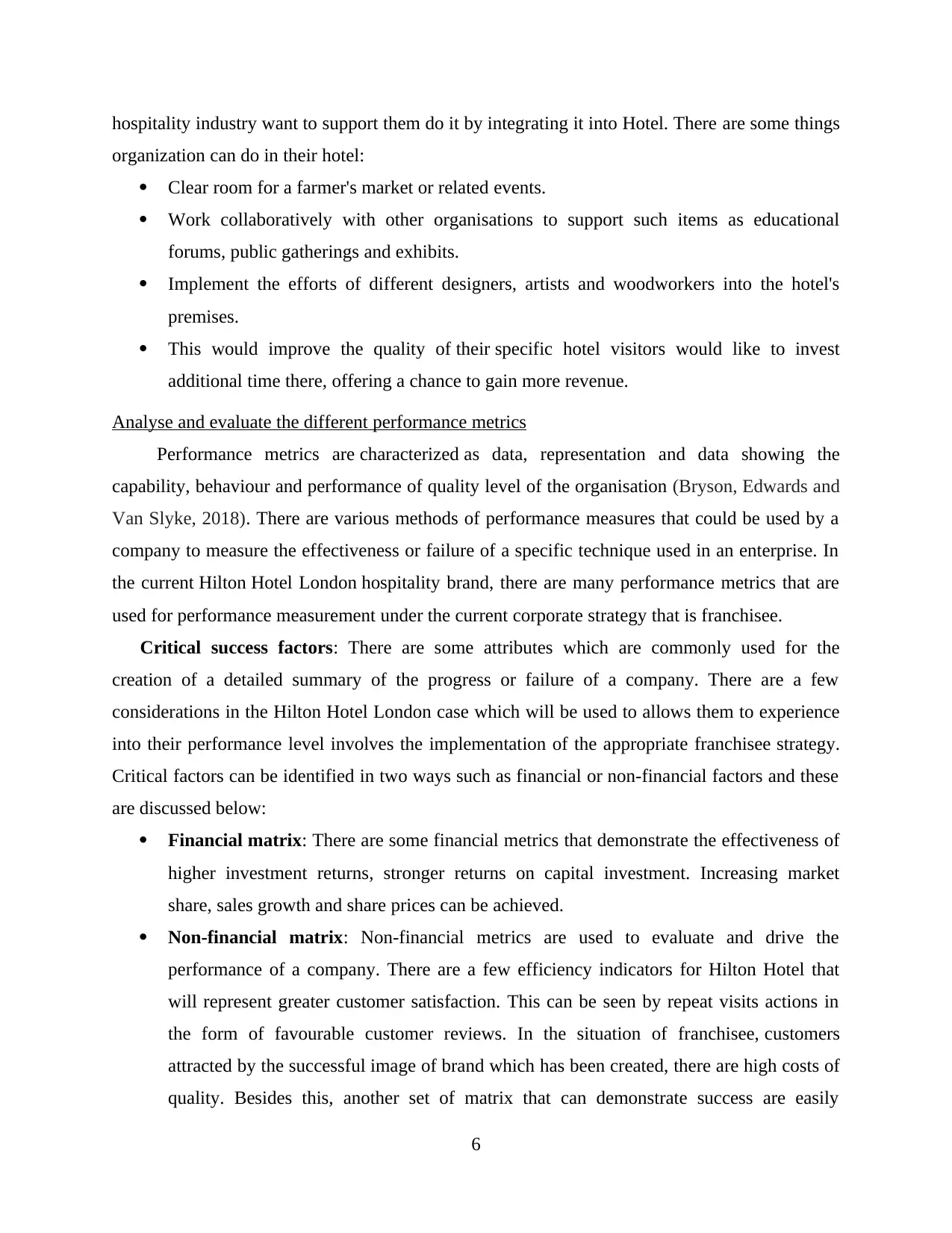
hospitality industry want to support them do it by integrating it into Hotel. There are some things
organization can do in their hotel:
Clear room for a farmer's market or related events.
Work collaboratively with other organisations to support such items as educational
forums, public gatherings and exhibits.
Implement the efforts of different designers, artists and woodworkers into the hotel's
premises.
This would improve the quality of their specific hotel visitors would like to invest
additional time there, offering a chance to gain more revenue.
Analyse and evaluate the different performance metrics
Performance metrics are characterized as data, representation and data showing the
capability, behaviour and performance of quality level of the organisation (Bryson, Edwards and
Van Slyke, 2018). There are various methods of performance measures that could be used by a
company to measure the effectiveness or failure of a specific technique used in an enterprise. In
the current Hilton Hotel London hospitality brand, there are many performance metrics that are
used for performance measurement under the current corporate strategy that is franchisee.
Critical success factors: There are some attributes which are commonly used for the
creation of a detailed summary of the progress or failure of a company. There are a few
considerations in the Hilton Hotel London case which will be used to allows them to experience
into their performance level involves the implementation of the appropriate franchisee strategy.
Critical factors can be identified in two ways such as financial or non-financial factors and these
are discussed below:
Financial matrix: There are some financial metrics that demonstrate the effectiveness of
higher investment returns, stronger returns on capital investment. Increasing market
share, sales growth and share prices can be achieved.
Non-financial matrix: Non-financial metrics are used to evaluate and drive the
performance of a company. There are a few efficiency indicators for Hilton Hotel that
will represent greater customer satisfaction. This can be seen by repeat visits actions in
the form of favourable customer reviews. In the situation of franchisee, customers
attracted by the successful image of brand which has been created, there are high costs of
quality. Besides this, another set of matrix that can demonstrate success are easily
6
organization can do in their hotel:
Clear room for a farmer's market or related events.
Work collaboratively with other organisations to support such items as educational
forums, public gatherings and exhibits.
Implement the efforts of different designers, artists and woodworkers into the hotel's
premises.
This would improve the quality of their specific hotel visitors would like to invest
additional time there, offering a chance to gain more revenue.
Analyse and evaluate the different performance metrics
Performance metrics are characterized as data, representation and data showing the
capability, behaviour and performance of quality level of the organisation (Bryson, Edwards and
Van Slyke, 2018). There are various methods of performance measures that could be used by a
company to measure the effectiveness or failure of a specific technique used in an enterprise. In
the current Hilton Hotel London hospitality brand, there are many performance metrics that are
used for performance measurement under the current corporate strategy that is franchisee.
Critical success factors: There are some attributes which are commonly used for the
creation of a detailed summary of the progress or failure of a company. There are a few
considerations in the Hilton Hotel London case which will be used to allows them to experience
into their performance level involves the implementation of the appropriate franchisee strategy.
Critical factors can be identified in two ways such as financial or non-financial factors and these
are discussed below:
Financial matrix: There are some financial metrics that demonstrate the effectiveness of
higher investment returns, stronger returns on capital investment. Increasing market
share, sales growth and share prices can be achieved.
Non-financial matrix: Non-financial metrics are used to evaluate and drive the
performance of a company. There are a few efficiency indicators for Hilton Hotel that
will represent greater customer satisfaction. This can be seen by repeat visits actions in
the form of favourable customer reviews. In the situation of franchisee, customers
attracted by the successful image of brand which has been created, there are high costs of
quality. Besides this, another set of matrix that can demonstrate success are easily
6
Paraphrase This Document
Need a fresh take? Get an instant paraphrase of this document with our AI Paraphraser
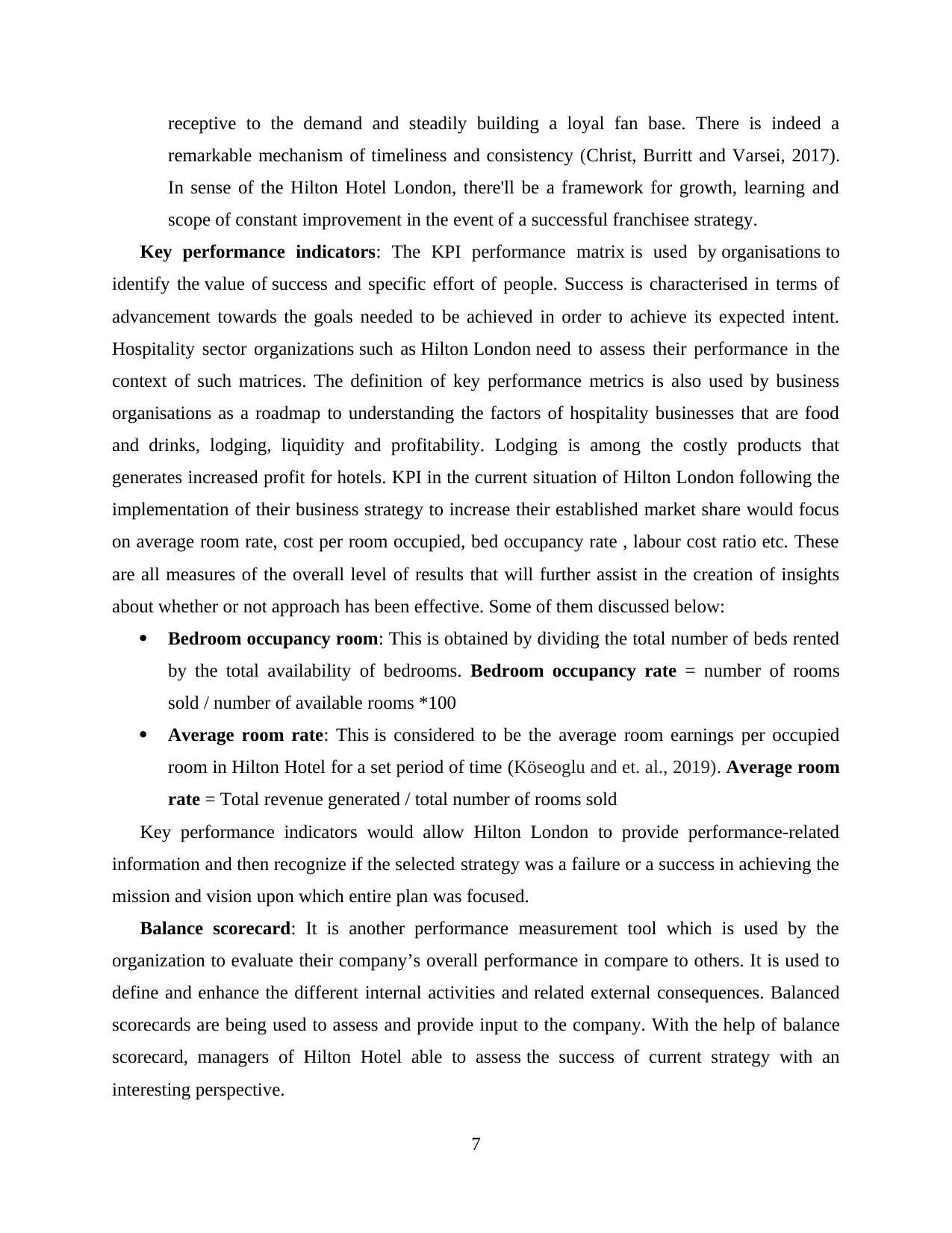
receptive to the demand and steadily building a loyal fan base. There is indeed a
remarkable mechanism of timeliness and consistency (Christ, Burritt and Varsei, 2017).
In sense of the Hilton Hotel London, there'll be a framework for growth, learning and
scope of constant improvement in the event of a successful franchisee strategy.
Key performance indicators: The KPI performance matrix is used by organisations to
identify the value of success and specific effort of people. Success is characterised in terms of
advancement towards the goals needed to be achieved in order to achieve its expected intent.
Hospitality sector organizations such as Hilton London need to assess their performance in the
context of such matrices. The definition of key performance metrics is also used by business
organisations as a roadmap to understanding the factors of hospitality businesses that are food
and drinks, lodging, liquidity and profitability. Lodging is among the costly products that
generates increased profit for hotels. KPI in the current situation of Hilton London following the
implementation of their business strategy to increase their established market share would focus
on average room rate, cost per room occupied, bed occupancy rate , labour cost ratio etc. These
are all measures of the overall level of results that will further assist in the creation of insights
about whether or not approach has been effective. Some of them discussed below:
Bedroom occupancy room: This is obtained by dividing the total number of beds rented
by the total availability of bedrooms. Bedroom occupancy rate = number of rooms
sold / number of available rooms *100
Average room rate: This is considered to be the average room earnings per occupied
room in Hilton Hotel for a set period of time (Köseoglu and et. al., 2019). Average room
rate = Total revenue generated / total number of rooms sold
Key performance indicators would allow Hilton London to provide performance-related
information and then recognize if the selected strategy was a failure or a success in achieving the
mission and vision upon which entire plan was focused.
Balance scorecard: It is another performance measurement tool which is used by the
organization to evaluate their company’s overall performance in compare to others. It is used to
define and enhance the different internal activities and related external consequences. Balanced
scorecards are being used to assess and provide input to the company. With the help of balance
scorecard, managers of Hilton Hotel able to assess the success of current strategy with an
interesting perspective.
7
remarkable mechanism of timeliness and consistency (Christ, Burritt and Varsei, 2017).
In sense of the Hilton Hotel London, there'll be a framework for growth, learning and
scope of constant improvement in the event of a successful franchisee strategy.
Key performance indicators: The KPI performance matrix is used by organisations to
identify the value of success and specific effort of people. Success is characterised in terms of
advancement towards the goals needed to be achieved in order to achieve its expected intent.
Hospitality sector organizations such as Hilton London need to assess their performance in the
context of such matrices. The definition of key performance metrics is also used by business
organisations as a roadmap to understanding the factors of hospitality businesses that are food
and drinks, lodging, liquidity and profitability. Lodging is among the costly products that
generates increased profit for hotels. KPI in the current situation of Hilton London following the
implementation of their business strategy to increase their established market share would focus
on average room rate, cost per room occupied, bed occupancy rate , labour cost ratio etc. These
are all measures of the overall level of results that will further assist in the creation of insights
about whether or not approach has been effective. Some of them discussed below:
Bedroom occupancy room: This is obtained by dividing the total number of beds rented
by the total availability of bedrooms. Bedroom occupancy rate = number of rooms
sold / number of available rooms *100
Average room rate: This is considered to be the average room earnings per occupied
room in Hilton Hotel for a set period of time (Köseoglu and et. al., 2019). Average room
rate = Total revenue generated / total number of rooms sold
Key performance indicators would allow Hilton London to provide performance-related
information and then recognize if the selected strategy was a failure or a success in achieving the
mission and vision upon which entire plan was focused.
Balance scorecard: It is another performance measurement tool which is used by the
organization to evaluate their company’s overall performance in compare to others. It is used to
define and enhance the different internal activities and related external consequences. Balanced
scorecards are being used to assess and provide input to the company. With the help of balance
scorecard, managers of Hilton Hotel able to assess the success of current strategy with an
interesting perspective.
7
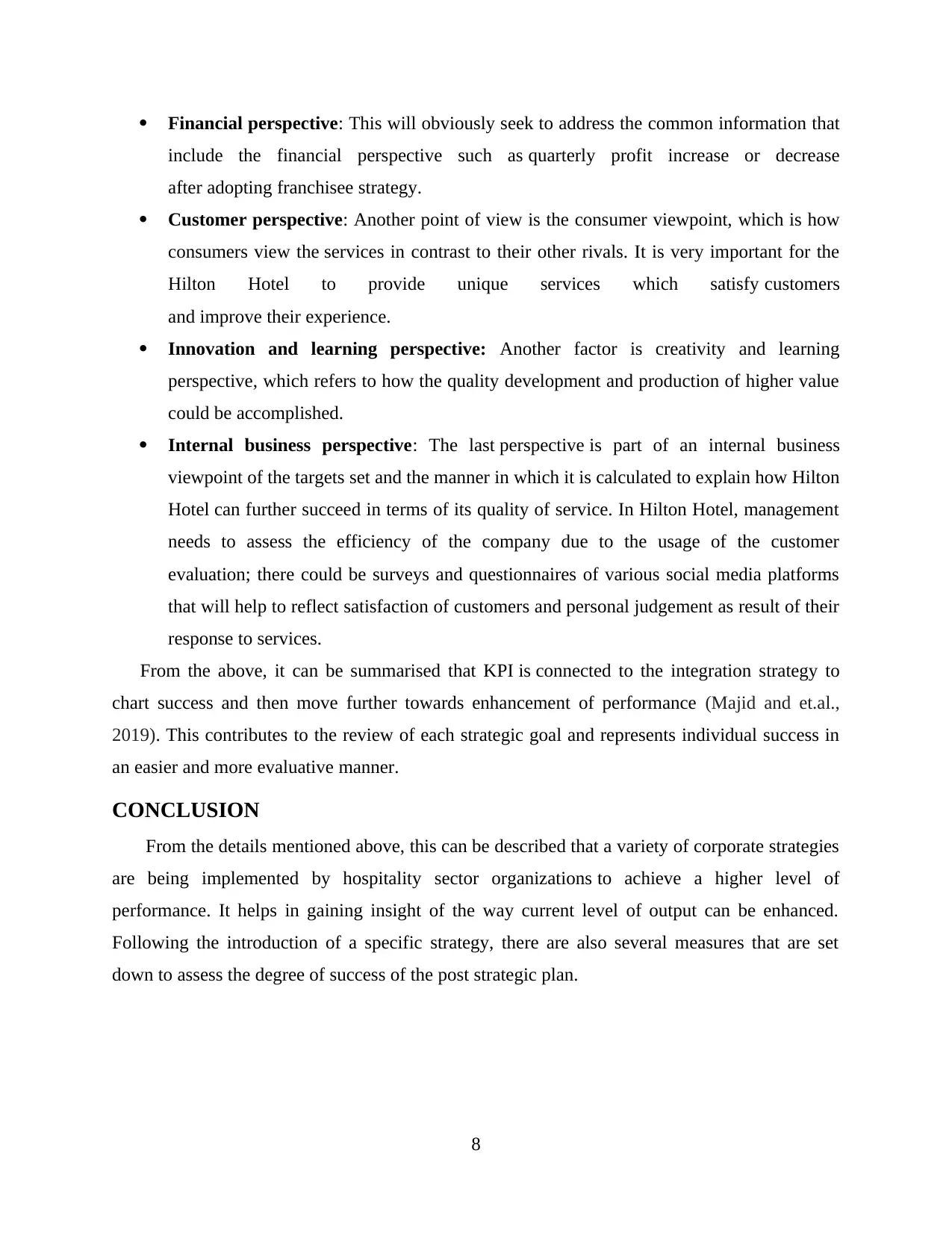
Financial perspective: This will obviously seek to address the common information that
include the financial perspective such as quarterly profit increase or decrease
after adopting franchisee strategy.
Customer perspective: Another point of view is the consumer viewpoint, which is how
consumers view the services in contrast to their other rivals. It is very important for the
Hilton Hotel to provide unique services which satisfy customers
and improve their experience.
Innovation and learning perspective: Another factor is creativity and learning
perspective, which refers to how the quality development and production of higher value
could be accomplished.
Internal business perspective: The last perspective is part of an internal business
viewpoint of the targets set and the manner in which it is calculated to explain how Hilton
Hotel can further succeed in terms of its quality of service. In Hilton Hotel, management
needs to assess the efficiency of the company due to the usage of the customer
evaluation; there could be surveys and questionnaires of various social media platforms
that will help to reflect satisfaction of customers and personal judgement as result of their
response to services.
From the above, it can be summarised that KPI is connected to the integration strategy to
chart success and then move further towards enhancement of performance (Majid and et.al.,
2019). This contributes to the review of each strategic goal and represents individual success in
an easier and more evaluative manner.
CONCLUSION
From the details mentioned above, this can be described that a variety of corporate strategies
are being implemented by hospitality sector organizations to achieve a higher level of
performance. It helps in gaining insight of the way current level of output can be enhanced.
Following the introduction of a specific strategy, there are also several measures that are set
down to assess the degree of success of the post strategic plan.
8
include the financial perspective such as quarterly profit increase or decrease
after adopting franchisee strategy.
Customer perspective: Another point of view is the consumer viewpoint, which is how
consumers view the services in contrast to their other rivals. It is very important for the
Hilton Hotel to provide unique services which satisfy customers
and improve their experience.
Innovation and learning perspective: Another factor is creativity and learning
perspective, which refers to how the quality development and production of higher value
could be accomplished.
Internal business perspective: The last perspective is part of an internal business
viewpoint of the targets set and the manner in which it is calculated to explain how Hilton
Hotel can further succeed in terms of its quality of service. In Hilton Hotel, management
needs to assess the efficiency of the company due to the usage of the customer
evaluation; there could be surveys and questionnaires of various social media platforms
that will help to reflect satisfaction of customers and personal judgement as result of their
response to services.
From the above, it can be summarised that KPI is connected to the integration strategy to
chart success and then move further towards enhancement of performance (Majid and et.al.,
2019). This contributes to the review of each strategic goal and represents individual success in
an easier and more evaluative manner.
CONCLUSION
From the details mentioned above, this can be described that a variety of corporate strategies
are being implemented by hospitality sector organizations to achieve a higher level of
performance. It helps in gaining insight of the way current level of output can be enhanced.
Following the introduction of a specific strategy, there are also several measures that are set
down to assess the degree of success of the post strategic plan.
8
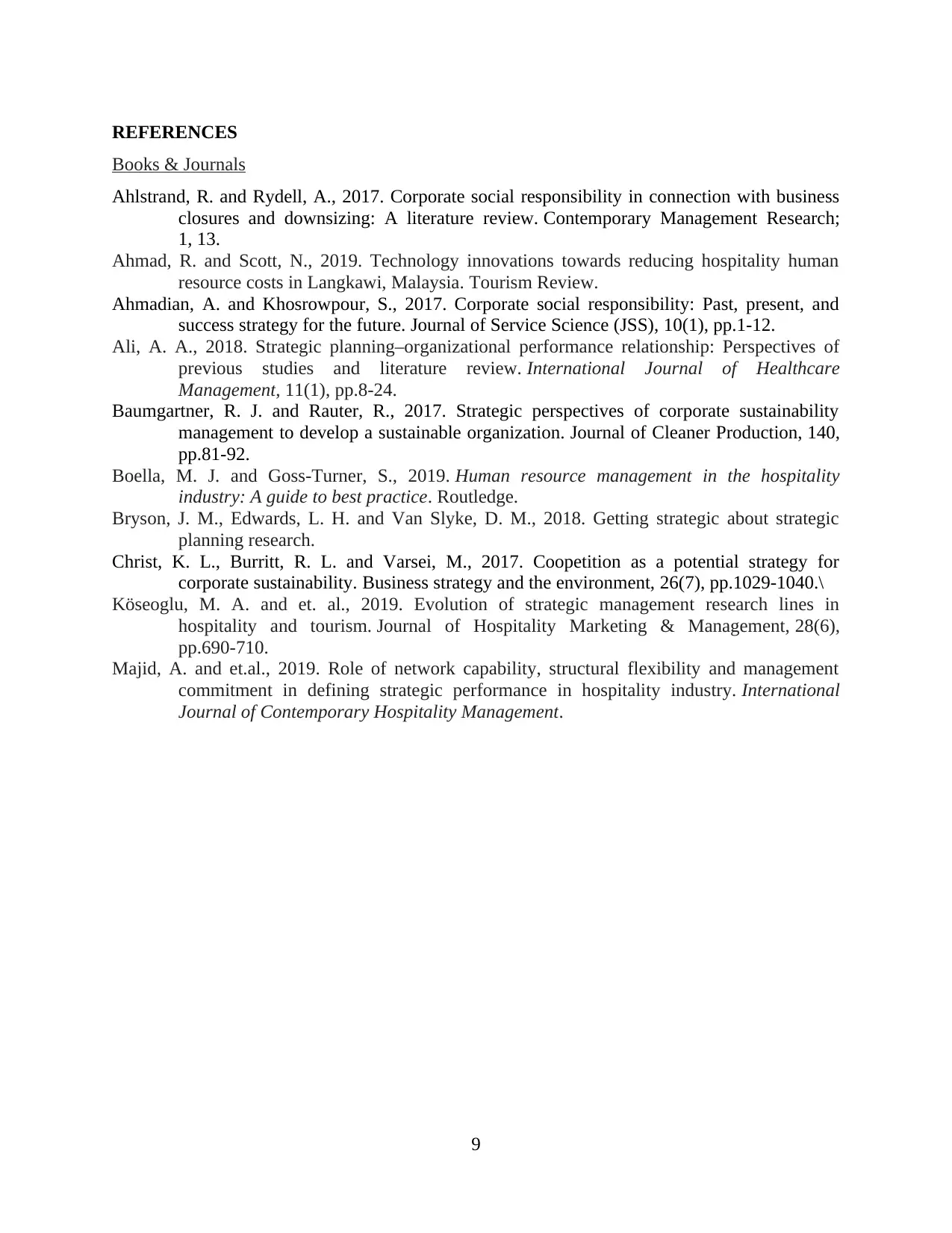
REFERENCES
Books & Journals
Ahlstrand, R. and Rydell, A., 2017. Corporate social responsibility in connection with business
closures and downsizing: A literature review. Contemporary Management Research;
1, 13.
Ahmad, R. and Scott, N., 2019. Technology innovations towards reducing hospitality human
resource costs in Langkawi, Malaysia. Tourism Review.
Ahmadian, A. and Khosrowpour, S., 2017. Corporate social responsibility: Past, present, and
success strategy for the future. Journal of Service Science (JSS), 10(1), pp.1-12.
Ali, A. A., 2018. Strategic planning–organizational performance relationship: Perspectives of
previous studies and literature review. International Journal of Healthcare
Management, 11(1), pp.8-24.
Baumgartner, R. J. and Rauter, R., 2017. Strategic perspectives of corporate sustainability
management to develop a sustainable organization. Journal of Cleaner Production, 140,
pp.81-92.
Boella, M. J. and Goss-Turner, S., 2019. Human resource management in the hospitality
industry: A guide to best practice. Routledge.
Bryson, J. M., Edwards, L. H. and Van Slyke, D. M., 2018. Getting strategic about strategic
planning research.
Christ, K. L., Burritt, R. L. and Varsei, M., 2017. Coopetition as a potential strategy for
corporate sustainability. Business strategy and the environment, 26(7), pp.1029-1040.\
Köseoglu, M. A. and et. al., 2019. Evolution of strategic management research lines in
hospitality and tourism. Journal of Hospitality Marketing & Management, 28(6),
pp.690-710.
Majid, A. and et.al., 2019. Role of network capability, structural flexibility and management
commitment in defining strategic performance in hospitality industry. International
Journal of Contemporary Hospitality Management.
9
Books & Journals
Ahlstrand, R. and Rydell, A., 2017. Corporate social responsibility in connection with business
closures and downsizing: A literature review. Contemporary Management Research;
1, 13.
Ahmad, R. and Scott, N., 2019. Technology innovations towards reducing hospitality human
resource costs in Langkawi, Malaysia. Tourism Review.
Ahmadian, A. and Khosrowpour, S., 2017. Corporate social responsibility: Past, present, and
success strategy for the future. Journal of Service Science (JSS), 10(1), pp.1-12.
Ali, A. A., 2018. Strategic planning–organizational performance relationship: Perspectives of
previous studies and literature review. International Journal of Healthcare
Management, 11(1), pp.8-24.
Baumgartner, R. J. and Rauter, R., 2017. Strategic perspectives of corporate sustainability
management to develop a sustainable organization. Journal of Cleaner Production, 140,
pp.81-92.
Boella, M. J. and Goss-Turner, S., 2019. Human resource management in the hospitality
industry: A guide to best practice. Routledge.
Bryson, J. M., Edwards, L. H. and Van Slyke, D. M., 2018. Getting strategic about strategic
planning research.
Christ, K. L., Burritt, R. L. and Varsei, M., 2017. Coopetition as a potential strategy for
corporate sustainability. Business strategy and the environment, 26(7), pp.1029-1040.\
Köseoglu, M. A. and et. al., 2019. Evolution of strategic management research lines in
hospitality and tourism. Journal of Hospitality Marketing & Management, 28(6),
pp.690-710.
Majid, A. and et.al., 2019. Role of network capability, structural flexibility and management
commitment in defining strategic performance in hospitality industry. International
Journal of Contemporary Hospitality Management.
9
1 out of 10
Related Documents
Your All-in-One AI-Powered Toolkit for Academic Success.
+13062052269
info@desklib.com
Available 24*7 on WhatsApp / Email
![[object Object]](/_next/static/media/star-bottom.7253800d.svg)
Unlock your academic potential
© 2024 | Zucol Services PVT LTD | All rights reserved.





